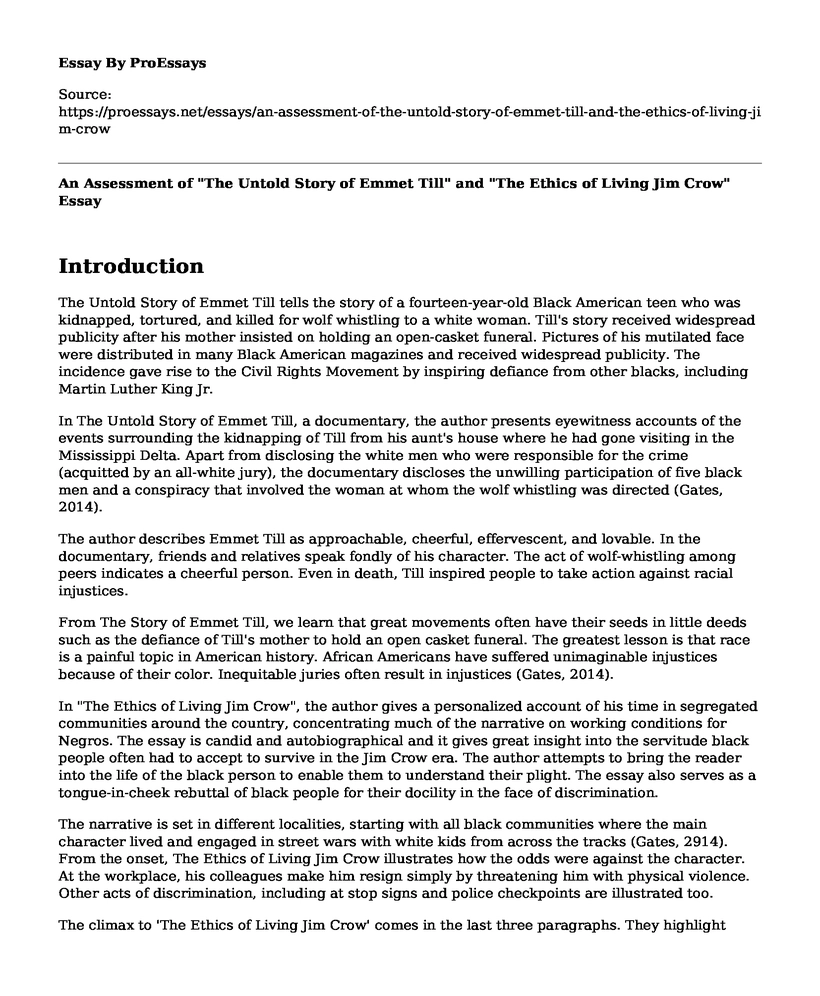Introduction
The Untold Story of Emmet Till tells the story of a fourteen-year-old Black American teen who was kidnapped, tortured, and killed for wolf whistling to a white woman. Till's story received widespread publicity after his mother insisted on holding an open-casket funeral. Pictures of his mutilated face were distributed in many Black American magazines and received widespread publicity. The incidence gave rise to the Civil Rights Movement by inspiring defiance from other blacks, including Martin Luther King Jr.
In The Untold Story of Emmet Till, a documentary, the author presents eyewitness accounts of the events surrounding the kidnapping of Till from his aunt's house where he had gone visiting in the Mississippi Delta. Apart from disclosing the white men who were responsible for the crime (acquitted by an all-white jury), the documentary discloses the unwilling participation of five black men and a conspiracy that involved the woman at whom the wolf whistling was directed (Gates, 2014).
The author describes Emmet Till as approachable, cheerful, effervescent, and lovable. In the documentary, friends and relatives speak fondly of his character. The act of wolf-whistling among peers indicates a cheerful person. Even in death, Till inspired people to take action against racial injustices.
From The Story of Emmet Till, we learn that great movements often have their seeds in little deeds such as the defiance of Till's mother to hold an open casket funeral. The greatest lesson is that race is a painful topic in American history. African Americans have suffered unimaginable injustices because of their color. Inequitable juries often result in injustices (Gates, 2014).
In "The Ethics of Living Jim Crow", the author gives a personalized account of his time in segregated communities around the country, concentrating much of the narrative on working conditions for Negros. The essay is candid and autobiographical and it gives great insight into the servitude black people often had to accept to survive in the Jim Crow era. The author attempts to bring the reader into the life of the black person to enable them to understand their plight. The essay also serves as a tongue-in-cheek rebuttal of black people for their docility in the face of discrimination.
The narrative is set in different localities, starting with all black communities where the main character lived and engaged in street wars with white kids from across the tracks (Gates, 2914). From the onset, The Ethics of Living Jim Crow illustrates how the odds were against the character. At the workplace, his colleagues make him resign simply by threatening him with physical violence. Other acts of discrimination, including at stop signs and police checkpoints are illustrated too.
The climax to 'The Ethics of Living Jim Crow' comes in the last three paragraphs. They highlight some of the acts of discrimination suffered by black people but also raise several key questions that black people themselves need to answer before confronting others on the issues of racial discrimination.
The main character in this story is naive, cowardly, a little aggressive, and showing a measure of defiance in his thinking. His expectation that his mother would sympathize with his fate after the street battle indicates naivety (Gates, 2014). In his time at the factory, the character lets his white co-workers push him around, but he maintains his pride and feels that black subservient ought to be rooted out.
Conclusion
From this essay, we learn firsthand the fate of black people during the Jim Crow era. It also suggests some soul-searching among blacks on the issue of race. While it may appear that all white people discriminated against blacks, the essay crashes this myth by attributing whites with some acts of kindles like lending the character a library book (Gates, 2014).
References
Gates, H. L. (2014). Norton Anthology of African American literature. New York: W. W. Norton & Company Publishers
Cite this page
An Assessment of "The Untold Story of Emmet Till" and "The Ethics of Living Jim Crow". (2022, May 05). Retrieved from https://proessays.net/essays/an-assessment-of-the-untold-story-of-emmet-till-and-the-ethics-of-living-jim-crow
If you are the original author of this essay and no longer wish to have it published on the ProEssays website, please click below to request its removal:
- Critical Essay Sample - The Tragedy of Othello
- Marxist Theory on Hamlet: Research Paper
- "What Was Served" by Douglas Bauer Essay Example
- Essay Example on Kubla Khan: Poem as Social Criticism by Samuel Taylor Coleridge
- Poetry Analysis Essay on Claude McKay's America: Love & Mixed Feelings in 1921
- Essay Example on The Human Stain: Identity, Change, and Freedom
- Paper Exploring Literary Devices in 'Scorched' by Wajdi Mouawad: Juxtaposition, Metaphor, and Paradox







